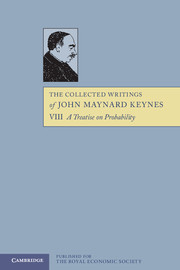Book contents
- Frontmatter
- Contents
- General Introduction
- Editorial Foreword by R. B. Braithwaite
- Editorial Note
- Preface to the First Edition
- I FUNDAMENTAL IDEAS
- II FUNDAMENTAL THEOREMS
- III INDUCTION AND ANALOGY
- IV SOME PHILOSOPHICAL APPLICATIONS OF PROBABILITY
- V THE FOUNDATIONS OF STATISTICAL INFERENCE
- 27 THE NATURE OF STATISTICAL INFERENCE
- 28 THE LAW OF GREAT NUMBERS
- 29 THE USE OF A PRIORI PROBABILITIES FOR THE PREDICTION OF STATISTICAL FREQUENCY—THE THEOREMS OF BERNOULLI, POISSON, AND TCHEBYCHEFF
- 30 THE MATHEMATICAL USE OF STATISTICAL FREQUENCIES FOR THE DETERMINATION OF PROBABILITY A POSTERIORI—THE METHODS OF LAPLACE
- 31 THE INVERSION OF BERNOULLI'S THEOREM
- 32 THE INDUCTIVE USE OF STATISTICAL FREQUENCIES FOR THE DETERMINATION OF PROBABILITY A POSTERIORI—THE METHODS OF LEXIS
- 33 OUTLINE OF A CONSTRUCTIVE THEORY
- Bibliography
- Index
30 - THE MATHEMATICAL USE OF STATISTICAL FREQUENCIES FOR THE DETERMINATION OF PROBABILITY A POSTERIORI—THE METHODS OF LAPLACE
from V - THE FOUNDATIONS OF STATISTICAL INFERENCE
Published online by Cambridge University Press: 05 November 2012
- Frontmatter
- Contents
- General Introduction
- Editorial Foreword by R. B. Braithwaite
- Editorial Note
- Preface to the First Edition
- I FUNDAMENTAL IDEAS
- II FUNDAMENTAL THEOREMS
- III INDUCTION AND ANALOGY
- IV SOME PHILOSOPHICAL APPLICATIONS OF PROBABILITY
- V THE FOUNDATIONS OF STATISTICAL INFERENCE
- 27 THE NATURE OF STATISTICAL INFERENCE
- 28 THE LAW OF GREAT NUMBERS
- 29 THE USE OF A PRIORI PROBABILITIES FOR THE PREDICTION OF STATISTICAL FREQUENCY—THE THEOREMS OF BERNOULLI, POISSON, AND TCHEBYCHEFF
- 30 THE MATHEMATICAL USE OF STATISTICAL FREQUENCIES FOR THE DETERMINATION OF PROBABILITY A POSTERIORI—THE METHODS OF LAPLACE
- 31 THE INVERSION OF BERNOULLI'S THEOREM
- 32 THE INDUCTIVE USE OF STATISTICAL FREQUENCIES FOR THE DETERMINATION OF PROBABILITY A POSTERIORI—THE METHODS OF LEXIS
- 33 OUTLINE OF A CONSTRUCTIVE THEORY
- Bibliography
- Index
Summary
Utilissima est aestimatio probabilitatum, quanquam in exemplis juridicis politicisque plerumque non tarn subtili calculo opus est, quam accurata omnium circumstantiarum enumeratione.
Leibniz.1. In the preceding chapter we have assumed that the probability of an event at each of a series of trials is given, and have considered how to infer from this the probabilities of the various possible frequencies of the event over the whole series, without discussing in detail by what method the initial probability had been determined. In statistical inquiries it is generally the case that this initial probability is based, not upon the principle of indifference, but upon the statistical frequencies of similar events which have been observed previously. In this chapter, therefore, we must commence the complementary part of our inquiry,—namely, into the method of deriving a measure of probability from an observed statistical frequency.
I do not myself believe that there is any direct and simple method by which we can make the transition from an observed numerical frequency to a numerical measure of probability. The problem, as I view it, is part of the general problem of founding judgments of probability upon experience, and can only be dealt with by the general methods of induction expounded in Part III. The nature of the problem precludes any other method, and direct mathematical devices can all be shown to depend upon insupportable assumptions. In the next chapters we will consider the applicability of general inductive methods to this problem, and in this we will endeavour to discredit the mathematical charlatanry by which, for a hundred years past, the basis of theoretical statistics has been greatly undermined.
- Type
- Chapter
- Information
- The Collected Writings of John Maynard Keynes , pp. 400 - 418Publisher: Royal Economic SocietyPrint publication year: 1978



